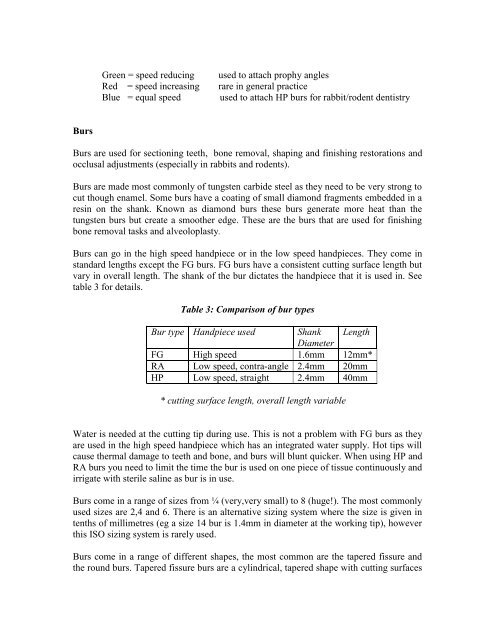Identification and Care of Veterinary Dental
Identification and Care of Veterinary Dental
Identification and Care of Veterinary Dental
You also want an ePaper? Increase the reach of your titles
YUMPU automatically turns print PDFs into web optimized ePapers that Google loves.
Green = speed reducing<br />
Red = speed increasing<br />
Blue = equal speed<br />
used to attach prophy angles<br />
rare in general practice<br />
used to attach HP burs for rabbit/rodent dentistry<br />
Burs<br />
Burs are used for sectioning teeth, bone removal, shaping <strong>and</strong> finishing restorations <strong>and</strong><br />
occlusal adjustments (especially in rabbits <strong>and</strong> rodents).<br />
Burs are made most commonly <strong>of</strong> tungsten carbide steel as they need to be very strong to<br />
cut though enamel. Some burs have a coating <strong>of</strong> small diamond fragments embedded in a<br />
resin on the shank. Known as diamond burs these burs generate more heat than the<br />
tungsten burs but create a smoother edge. These are the burs that are used for finishing<br />
bone removal tasks <strong>and</strong> alveoloplasty.<br />
Burs can go in the high speed h<strong>and</strong>piece or in the low speed h<strong>and</strong>pieces. They come in<br />
st<strong>and</strong>ard lengths except the FG burs. FG burs have a consistent cutting surface length but<br />
vary in overall length. The shank <strong>of</strong> the bur dictates the h<strong>and</strong>piece that it is used in. See<br />
table 3 for details.<br />
Table 3: Comparison <strong>of</strong> bur types<br />
Bur type H<strong>and</strong>piece used Shank Length<br />
Diameter<br />
FG High speed 1.6mm 12mm*<br />
RA Low speed, contra-angle 2.4mm 20mm<br />
HP Low speed, straight 2.4mm 40mm<br />
* cutting surface length, overall length variable<br />
Water is needed at the cutting tip during use. This is not a problem with FG burs as they<br />
are used in the high speed h<strong>and</strong>piece which has an integrated water supply. Hot tips will<br />
cause thermal damage to teeth <strong>and</strong> bone, <strong>and</strong> burs will blunt quicker. When using HP <strong>and</strong><br />
RA burs you need to limit the time the bur is used on one piece <strong>of</strong> tissue continuously <strong>and</strong><br />
irrigate with sterile saline as bur is in use.<br />
Burs come in a range <strong>of</strong> sizes from ¼ (very,very small) to 8 (huge!). The most commonly<br />
used sizes are 2,4 <strong>and</strong> 6. There is an alternative sizing system where the size is given in<br />
tenths <strong>of</strong> millimetres (eg a size 14 bur is 1.4mm in diameter at the working tip), however<br />
this ISO sizing system is rarely used.<br />
Burs come in a range <strong>of</strong> different shapes, the most common are the tapered fissure <strong>and</strong><br />
the round burs. Tapered fissure burs are a cylindrical, tapered shape with cutting surfaces

















